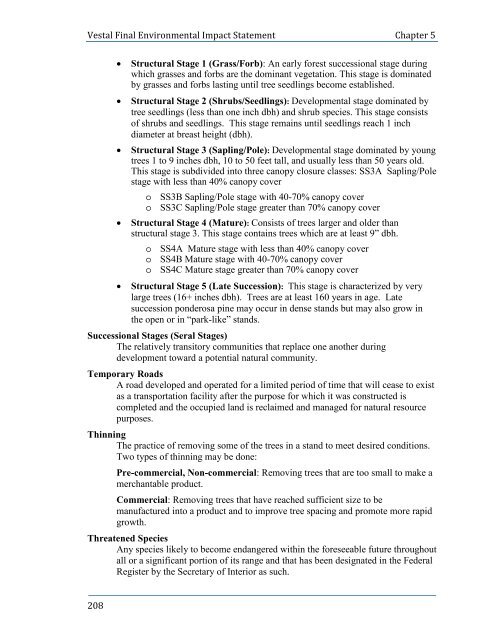Final Environmental Impact Statement
Final Environmental Impact Statement
Final Environmental Impact Statement
You also want an ePaper? Increase the reach of your titles
YUMPU automatically turns print PDFs into web optimized ePapers that Google loves.
Vestal <strong>Final</strong> <strong>Environmental</strong> <strong>Impact</strong> <strong>Statement</strong> Chapter 5<br />
208<br />
• Structural Stage 1 (Grass/Forb): An early forest successional stage during<br />
which grasses and forbs are the dominant vegetation. This stage is dominated<br />
by grasses and forbs lasting until tree seedlings become established.<br />
• Structural Stage 2 (Shrubs/Seedlings): Developmental stage dominated by<br />
tree seedlings (less than one inch dbh) and shrub species. This stage consists<br />
of shrubs and seedlings. This stage remains until seedlings reach 1 inch<br />
diameter at breast height (dbh).<br />
• Structural Stage 3 (Sapling/Pole): Developmental stage dominated by young<br />
trees 1 to 9 inches dbh, 10 to 50 feet tall, and usually less than 50 years old.<br />
This stage is subdivided into three canopy closure classes: SS3A Sapling/Pole<br />
stage with less than 40% canopy cover<br />
o SS3B Sapling/Pole stage with 40-70% canopy cover<br />
o SS3C Sapling/Pole stage greater than 70% canopy cover<br />
• Structural Stage 4 (Mature): Consists of trees larger and older than<br />
structural stage 3. This stage contains trees which are at least 9” dbh.<br />
o SS4A Mature stage with less than 40% canopy cover<br />
o SS4B Mature stage with 40-70% canopy cover<br />
o SS4C Mature stage greater than 70% canopy cover<br />
• Structural Stage 5 (Late Succession): This stage is characterized by very<br />
large trees (16+ inches dbh). Trees are at least 160 years in age. Late<br />
succession ponderosa pine may occur in dense stands but may also grow in<br />
the open or in “park-like” stands.<br />
Successional Stages (Seral Stages)<br />
The relatively transitory communities that replace one another during<br />
development toward a potential natural community.<br />
Temporary Roads<br />
A road developed and operated for a limited period of time that will cease to exist<br />
as a transportation facility after the purpose for which it was constructed is<br />
completed and the occupied land is reclaimed and managed for natural resource<br />
purposes.<br />
Thinning<br />
The practice of removing some of the trees in a stand to meet desired conditions.<br />
Two types of thinning may be done:<br />
Pre-commercial, Non-commercial: Removing trees that are too small to make a<br />
merchantable product.<br />
Commercial: Removing trees that have reached sufficient size to be<br />
manufactured into a product and to improve tree spacing and promote more rapid<br />
growth.<br />
Threatened Species<br />
Any species likely to become endangered within the foreseeable future throughout<br />
all or a significant portion of its range and that has been designated in the Federal<br />
Register by the Secretary of Interior as such.

















